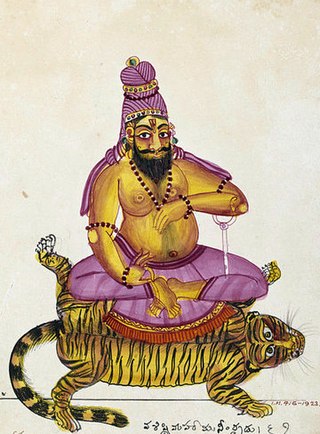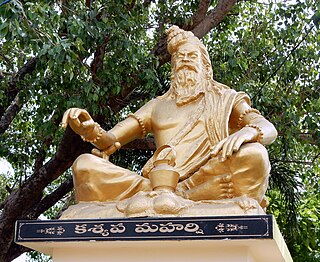
In Indian religions, a rishi is an accomplished and enlightened person. They find mentions in various Vedic texts. Rishis are believed to have composed hymns of the Vedas. The Post-Vedic tradition of Hinduism regards the rishis as "great yogis" or "sages" who after intense meditation (tapas) realized the supreme truth and eternal knowledge, which they composed into hymns. The term appears in Pali literature as Ishi; in Buddhism they can be either Buddhas, Paccekabuddhas, Arahats or a monk of high rank.

Atri or Attri is a Vedic sage, who is credited with composing numerous hymns to Agni, Indra, and other Vedic deities of Hinduism. Atri is one of the Saptarishi in the Hindu tradition, and the one most mentioned in its scripture Rigveda.
{{Infobox deity | image = Bharadwaja (detail).jpg | affiliation = Brahmarshi | father = Dronacharya

Bhrigu was a rishi in Hinduism. He was one of the seven great sages, the Saptarshis, and one of the many Prajapatis created by Brahma. The first compiler of predictive astrology and also the author of Bhrigu Samhita, an astrological (jyotisha) classic. Bhrigu is considered a manasaputra ("mind-born-son") of Brahma. The adjectival form of the name, Bhargava, is used to refer to the descendants and the school of Bhrigu. According to Manusmriti, Bhrigu was a compatriot of and lived during the time of Manu, the progenitor of humanity. Along with Manu, Bhrigu had made important contributions to the Manusmriti, which was constituted out of a sermon to a congregation of saints in the state of Brahmavarta, after the great floods in this area. As per the Skanda Purana, Bhrigu migrated to Bhrigukaccha, modern Bharuch, on the banks of the Narmada river in Gujarat, leaving his son Chyavana at Dhosi Hill.

Krishna Dvaipayana, better known as Vyasa or Veda Vyasa, is a revered rishi (sage) portrayed in most Hindu traditions. He is traditionally regarded as the author of a number of Hindu texts, including the Bhagavata Purana and the Mahābhārata.
The name Gautam is one of the ancient Indian names and is derived from the Sanskrit roots "gŐ(गः)" and "tama (तम)". "Tama" means "darkness" and "gŐ" means inter alia "bright light". Together they indicate one, who dispels darkness by his brilliance.

Shaunaka is the name applied to teachers, and to a Shakha of the Atharvaveda. It is especially the name of a celebrated Sanskrit grammarian, author of the Ṛgveda-Prātiśākhya, the Bṛhaddevatā, the Caraṇa-vyūha and six Anukramaṇīs (indices) to the Rigveda. He is claimed as the teacher of Katyayana and especially of Ashvalayana, and is said to have united the Bashkala and Shakala Shakhas of the Rigveda. In legend, he is sometimes identified with Gritsamada, a Vedic rishi.

Vasishtha is one of the oldest and revered Vedic rishis or sages, and one of the Saptarishis. Vasishtha is credited as the chief author of Mandala 7 of the Rigveda. Vasishtha and his family are mentioned in Rigvedic verse 10.167.4, other Rigvedic mandalas and in many Vedic texts. His ideas have been influential and he was called the first sage of the Vedanta school of Hindu philosophy by Adi Shankara.

Chyavana was a sage (rishi) in Hinduism. He was a son of Bhrigu, also known as Bhrigu Varuni in the Upanishads, and is known for his rejuvenation through a special herbal paste or tonic known as chyavanaprasham, which was prepared by the Ashvins. According to the Mahabharata, he was powerful enough to oppose the celestial thunderbolt (vajra) of Indra, and was responsible for the Ashvins getting their share of the sacrificial offerings. He created an asura, Mada, to achieve it.
Pulastya is one of the ten Prajapati, and one of the mind-born sons of Brahma in Hinduism. He is also one of the Saptarishi in the first age of Manu, the Manvantara.
Kankhal is a small colony in Haridwar in the Haridwar district of Uttarakhand state in India.

Marichi or Mareechi or Marishi is the mind-born son of Brahma, and one of the Saptarishi in Hindu mythology. He is also the father of Kashyapa, and the grandfather of the devas and the asuras.

Dhosi Hill is an important Vedic period site, an extinct volcano, standing alone at the north-west end of the Aravalli mountain range. Its height varies from about 345 to 470 meters from the surrounding lands and 740 meters from the sea level. At present the hill has temples, a pakka pond, ruins of a fort, caves and forest around it. In the ancient times, as per various scriptures like Mahabharata - Vanparv, Puranas, Shathpath Brahmana etc. the hill had Ashrams of various Rishis who made contributions to Vedic scriptures.

Kashyapa is a revered Vedic sage of Hinduism. He is one of the Saptarishis, the seven ancient sages of the Rigveda. Kashyapa is the most ancient and venerated rishi, along with the other Saptarishis, listed in the colophon verse in the Brihadaranyaka Upanishad.

The Advaita Guru-Paramparā is the traditional lineage (parampara) of divine, Vedic and historical teachers of Advaita Vedanta. It begins with the Daiva-paramparā, the gods; followed by the Ṛṣi-paramparā, the Vedic seers; and then the Mānava-paramparā, with the historical teachers Gaudapada and Adi Shankara, and four of Shankara's pupils. Of the five contemporary acharyas, the heads of the five Advaita mathas, four acharyas trace their lineage to those four pupils and one to Adi Shankara himself.
Kratu is described as one of the manasaputras, the mind-born children of the creator deity, Brahma, in Hinduism. He is also a rishi, who appears in two different ages.
Yajnavalkya Ashram was a gurukul of the Indian philosopher Yajnavalkya. It is believed that Yajnavalkya got his enlightenment here. It is the place where he wrote many texts of Ancient Indian philosophy. He wrote Shatapatha Brahman, Yajnavalkya Smriti, Brihadaranyaka Upanishad, Yoga Yajnavalkya and many more. Yajnavalkya Ashram is situated at Jagban village of Madhubani district in Mithila region of Bihar.
Brahmanical System of Education was an ancient system of education in ancient India. It was based on Vedic tradition. The main objective of the educational system was to make the students self-reliant. The curriculum of the system was based on Vedas. The important contributions of the system were developments of Upanishads, six schools of the Indian philosophy and the ancient texts of India.

Pundrik Ashram is a Hindu monastery related to the Vedic sage Pundrik. The sage Pundrik was an Indian sage mentioned in the Indian religious texts. He was born in a Brahmin family. He was an ascetic connoisseur of Vedas, lover of self-study, conqueror of senses and forgiving. He was committed to observance of cosmic-Vedic deeds. Pundrik Ashram is located at Punauradham in Sitamarhi district of Mithila region of Bihar. According to legend, Punauradham is considered as the penance place of Pundrik Rishi.

Yajnavalkya Jayanti is a Hindu festival observed to celebrate the birth of the Vedic sage Yajnavalkya.












